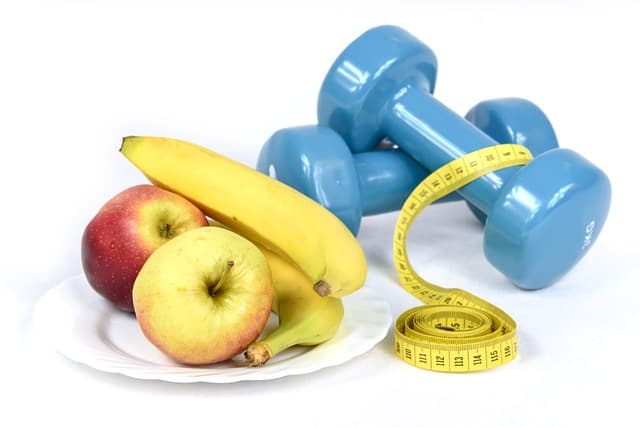Effective fitness consists not only of regular workouts, but also of preparation and recovery after them. The quality of the training process is strongly influenced by your diet and eating habits. The rule “Don’t eat an hour before and after exercise” is necessary but not sufficient. If you are working for results, follow our simple recommendations and it won’t take long!
Preparation
With a normal lifestyle, the body consumes 2-3 liters of water daily. With intense physical activity, more fluid is required, lack of proper attention to this feature can lead to dehydration. Therefore, before training for 1-2 hours it is useful to drink 0.5-0.6 liters of water (without gas). It is also desirable to take water with you and to the training. Additional fluid allows you to more effectively eliminate slags and metabolic products, the production of which due to the acceleration of metabolism becomes more intense. In addition, it is useful to enrich your diet on training days with products containing catechins: berries, fruits, green tea, cocoa beans. Catechins help fight excess kilocalories by regulating blood sugar levels, having antioxidant activity and helping to increase energy expenditure and speed up metabolism.
Meals on the day of training, if it is planned for the early hours, should be light: it is useful to eat granola with yogurt or drink tea with honey. In the afternoon, you can eat 2-3 hours, including legumes or cereals (the content of complex carbohydrates should be approximately 50-100 g) and 100-150 g of seafood or lean chicken. Do not completely neglect food: starvation lowers sugar levels and slows metabolism, which negatively affects the effectiveness of training.
During training
Intensive physical exercise is an additional load for the body. Already during the warm-up, it begins to reorganize itself for active activity, and resources are mobilized.
The source of energy for muscles is glycogen. It is intensively consumed during training. In addition, as a result of activation of metabolic processes, lactic acid accumulates in the muscles, which prevents their contraction and creates painful sensations after exercise. Need: remove acid from the body
To obtain energy, the body first of all begins to use carbohydrates, then – fats. It is at this point in the workout that the feeling of hunger appears.
You should: refrain from eating anything for at least an hour after your workout.
Active muscles require additional oxygen and nutrition.
You should: provide your muscles with the necessary amount of substances.
Intense sweating leads to blood clotting.
Need: prevent possible blood clots.
During training, pay close attention to possible signs of dehydration: headache, dizziness, dry mouth. In the future, this can progress to general weakness, increased fatigue, loss of activity. Therefore, when the first symptoms of dehydration appear, you should start drinking water without delay. Interrupt training for this purpose until the condition normalizes. Approximate volume of water for a person weighing 60-75 kg: 100-150 ml per 10-15 minutes. More intense exercise requires more fluid, it is also useful to use not pure water, but special isotonic drinks that contain vitamins, trace elements and carbohydrates. Eating during training, on the contrary, is undesirable. Only if the duration of training is more than 2 hours, you should have a little bit of dried fruit.
After training
The main tasks of this period – to restore the normal rhythm of heartbeat and as quickly as possible to remove from the body accumulated slags formed as a result of muscle activity. For this purpose, you need additional fluids. In addition, you need to “return” to the body useful trace elements and vitamins that came out with sweat during training. Drink a glass of freshly squeezed apple or carrot juice half an hour after the exercise, it will also help to restore energy.
An hour after exercise is the time to eat. What is the best way to eat after a workout? In the first half of the day, those who want to lose weight can eat a green salad and boiled salmon, and those who are working on gaining muscle mass can eat grilled chicken breast and 100 grams of rice. In the second half of the day, you can limit yourself to 100-150 g of low-fat cottage cheese or 1-2 glasses of low-fat kefir.
Other methods of recovery
Walking. In order to calm the pulse and bring it to 60-80 beats, it is useful to walk a little quietly, better in the fresh air. This allows you to prolong the breakdown of fat, as well as provide the body with additional oxygen. When walking, the muscles return to their normal mode of operation within 10 minutes. The total recommended duration of the walk is 30-40 minutes.
Pool. It helps to restore the thermoregulatory system and muscle tissue, removes lactic acid, and creates additional aerobic exercise. Immediately after training it is useful to swim for 15-20 minutes.
Bath. Contributes to strengthening the immune system, improving the condition of ligaments and joints. On the other hand, bathing puts additional strain on the thermoregulatory system and the heart, and should be used with caution, especially after an intense workout. Recommended regime: 2-3 sessions, from 5 to 15 minutes each, after high loads it is better to limit yourself to one 5-minute session.

